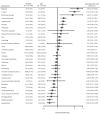Differences in the pre-hospital management of women and men with stroke by emergency medical services in New South Wales
- PMID: 35831059
- PMCID: PMC9541458
- DOI: 10.5694/mja2.51652
Differences in the pre-hospital management of women and men with stroke by emergency medical services in New South Wales
Abstract
Objectives: To examine whether pre-hospital emergency medical service care differs for women and men subsequently admitted to hospital with stroke.
Design, setting, participants: Population-based cohort study; analysis of linked Admitted Patient Data Collection and NSW Ambulance data for people admitted to New South Wales hospitals with a principal diagnosis of stroke at separation, 1 July 2005 - 31 December 2018.
Main outcome measures: Emergency medical service assessments, protocols, and management for patients subsequently diagnosed with stroke, by sex.
Results: Of 202 231 people hospitalised with stroke (mean age, 73 [SD, 14] years; 98 599 women [51.0%]), 101 357 were conveyed to hospital by ambulance (50.1%). A larger proportion of women than men travelled by ambulance (52.4% v 47.9%; odds ratio [OR], 1.09; 95% CI, 1.07-1.11), but time between the emergency call and emergency department admission was similar for both sexes. The likelihood of being assessed as having a stroke (adjusted OR [aOR], 0.97; 95% CI, 0.93-1.01) or subarachnoid haemorrhage (aOR, 1.22; 95% CI, 0.73-2.03) was similar for women and men, but women under 70 years of age were less likely than men to be assessed as having a stroke (aOR, 0.89; 95% CI, 0.82-0.97). Women were more likely than men to be assessed by paramedics as having migraine, other headache, anxiety, unconsciousness, hypertension, or nausea. Women were less likely than men to be managed according to the NSW Ambulance pre-hospital stroke care protocol (aOR, 0.95; 95% CI, 0.92-0.97), but the likelihood of basic pre-hospital care was similar for both sexes (aOR, 1.01; 95% CI, 0.99-1.04).
Conclusion: Our large population-based study identified sex differences in pre-hospital management by emergency medical services of women and men admitted to hospital with stroke. Paramedics should receive training that improves the recognition of stroke symptoms in women.
Keywords: Stroke.
© 2022 The Authors. Medical Journal of Australia published by John Wiley & Sons Australia, Ltd on behalf of AMPCo Pty Ltd.
Conflict of interest statement
No relevant disclosures.
Figures



Comment in
-
Stroke is more than a hemiparesis: the pre-hospital detection of stroke.Med J Aust. 2022 Aug 1;217(3):140-141. doi: 10.5694/mja2.51654. Epub 2022 Jul 12. Med J Aust. 2022. PMID: 35820662 No abstract available.
-
Differences in the pre-hospital management of women and men with stroke by emergency medical services in New South Wales.Med J Aust. 2023 Feb 6;218(2):96. doi: 10.5694/mja2.51810. Epub 2022 Dec 10. Med J Aust. 2023. PMID: 36495867 Free PMC article. No abstract available.
-
Differences in the pre-hospital management of women and men with stroke by emergency medical services in New South Wales.Med J Aust. 2023 Feb 6;218(2):96. doi: 10.5694/mja2.51809. Epub 2022 Dec 10. Med J Aust. 2023. PMID: 36495870 No abstract available.
References
-
- Emberson J, Lees KR, Lyden P, et al; Stroke Thrombolysis Trialists' Collaborative Group. Effect of treatment delay, age, and stroke severity on the effects of intravenous thrombolysis with alteplase for acute ischemic stroke: a meta‐analysis of individual patient data from randomized trials. Lancet 2014; 384: 1929‐1935. - PMC - PubMed
-
- Saver JL, Goyal M, van der Lugt A, et al; HERMES Collaborators. Time to treatment with endovascular thrombectomy and outcomes from ischemic stroke: a meta‐analysis. JAMA 2016; 316: 1279‐1288. - PubMed
-
- Reeves MJ, Fonarow GC, Zhao X, et al; Get With The Guidelines‐Stroke Steering Committee and Investigators. Quality of care in women with ischemic stroke in the GWTG program. Stroke 2009; 40: 1127‐1133. - PubMed
-
- Park SJ, Shin SD, Ro YS, et al. Gender differences in emergency stroke care and hospital outcome in acute ischemic stroke: a multicenter observational study. Am J Emerg Med 2013; 31: 178‐184. - PubMed
MeSH terms
LinkOut - more resources
Full Text Sources
Medical
Miscellaneous

